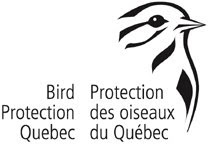A big thank you to Marc for volunteering his time to show us around. For those on the trip, Marc made a point of emailing me and asked that I express how much he enjoyed the outing with our group and offering to come with us again in the future.
As far as the birds were concerned our sightings were surprisingly limited for an early June outing. A total of only 39 species were seen or heard by the group. Highlights were Indigo Buntings (male and female - this latter surprising many people by her drabness) and close views of Magnolia Warblers and Alder Flycatchers actually in Alder bushes.
But the birds of the day were most certainly the Peregrine Falcons - 2 adults and 3 young (there are apparently 4 but we saw no more than 3 at one time) in their awkward teenage phase as they still have some downy feathers but are starting to grow their proper wing feathers. At on point a group of 9 Turkey Vultures started soaring a little too close to the falcon nest and the parent falcons put on quite a show as they dove and harassed the vultures until they left the area. The vultures were no slouches either when it came to their abilities to manoeuver as they avoided the agitated falcons. This interaction continued for several minutes high above us near the cliff face.
Of non-avian interest was an unexpected lack of black flies and mosquitoes. After all, this was early June in the Laurentians, where and when we usually expect to give our annual blood donation. Insect repellant was not even needed. Could there be a correlation with the lack of songbirds? Dragonflies, however, were in good supply. - Wayne Grubert
Our complete list of bird 39 species includes - Mallard - 1, Ruffed Grouse - 1, Turkey Vultures - 9, Red-shouldered Hawk - 1, Broad-winged Hawk - 3, Ruby-throated Hummingbird - 2, Yellow-bellied Sapsuckers - 2, Downy Woodpecker - 1, Hairy Woodpecker - 1, Northern Flicker - 1, Pileated Woodpecker - 1, Peregrine Falcons - 5 - 2 adults, 3 young, Alder Flycatcher - 3, Warbling Vireo - 2, Red-eyed Vireo - 12, Blue Jay - 6, American Crow - 12, Common Raven - 2, Black-capped Chickadee - 6, Red-breasted Nuthatch - 1, Veery - 2, American Robin - 4, European Starling - 2, Cedar Waxwing - 4, Ovenbird - 3, Black-and-white Warbler - 2, Nashville Warbler - 1, Common Yellowthroat - 1, Magnolia Warbler - 3, Yellow Warbler - 1, Chestnut-sided Warbler - 2, Black-throated Blue Warbler - 3, Chipping Sparrow - 1, Song Sparrow - 3, Northern Cardinal - 2, Indigo Bunting - 3, Red-winged Blackbird - 2, Pine Siskin - 1, American Goldfinch - 12
Canard colvert - 1, Gélinotte huppée - 1, Urubu à tête rouge - 9, Buse à épaulettes - 1, Petite Buse - 3, Colibri à gorge rubis - 2, Pic maculé - 2, Pic mineur - 1, Pic chevelu - 1, Pic flaboyant - 1, Grand pic - 1, Faucon pèlerin - 5 - 2 adultes, 3 jeunes, Moucherolle des aulnes - 3, Viréo mélodieux - 2, Viréo aux yeux rouges - 12, Geai bleu - 6, Corneille d'Amérique - 12, Grand corbeau - 2, Mésange à tête noire - 6, Sittelle à poitrine rousse - 1, Grive fauve - 2, Merle d'Amérique - 4, Étourneau sansonnet - 2, Jaseur d'Amérique- 4, Paruline couronnée - 3, Paruline Noir et blanc - 2 , Paruline à joues grise - 1, Paruline masquée - 1, Paruline à à tête cendrée - 3, Paruline jaune - 1, Paruline à flancs marron - 2, Paruline bleue - 3, Bruant familier - 1, Bruant chanteur - 3, Cardinal rouge - 2 , Passerin indigo - 3, Carouge à épaulettes - 2, Tarin des pins - 1, Chardonneret jaune





No comments:
Post a Comment